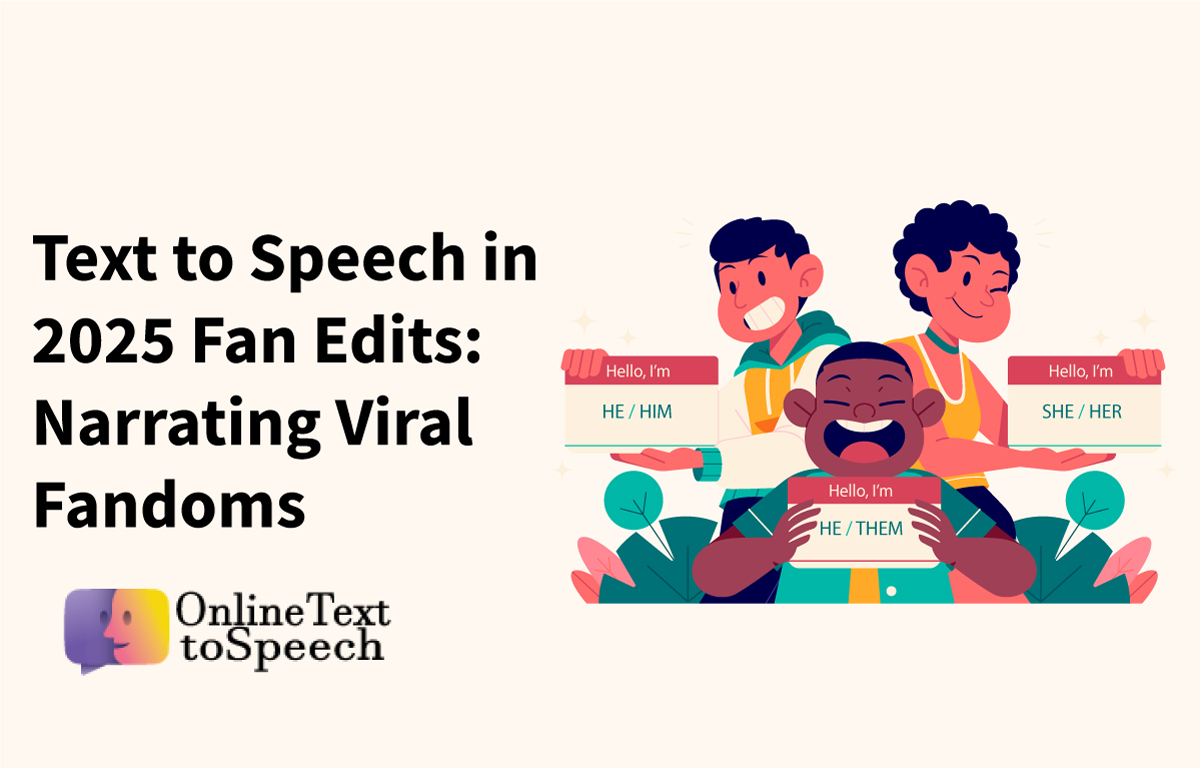
In 2025, fan edits are no longer just flashy visuals or dramatic slow-motion clips. They’ve evolved into emotional, narrative-driven short films, and at the heart of this transformation is text to speech technology. As short-form content continues to dominate platforms like TikTok, YouTube Shorts, and Instagram Reels, a new wave of creators is using AI-generated voices to tell compelling stories through their edits.
These edits, often rooted in fictional universes or celebrity fandoms, now feature emotionally charged monologues, poetic narrations, and even dialogues — all generated without a microphone. The blend of visuals, soundtracks, and seamless narration has turned fan edits into immersive storytelling experiences. And it’s text to speech free tools that are quietly powering this cultural shift.
As AI continues to shape digital creativity, let’s dive into how fan editors are embracing TTS tech to voice their edits, grow their reach, and redefine what it means to create viral content in 2025.
How AI Text to Speech Is Fueling the Fan Edit Boom
The rising quality of AI text-to-speech has blurred the line between human and synthetic narration. Today’s AI-generated voices can express tone, pacing, and emotion, making them ideal for storytelling. Fan editors who previously relied on captions or music now have the freedom to speak directly to their audience without using their voices.
Narrative-driven edits — such as a monologue from a villain’s perspective, a motivational speech layered over character clips, or a “what if” scenario voiced by an alternate character — are becoming more popular. These styles resonate deeply with viewers, and that emotional connection increases shares, likes, and algorithmic visibility.
This boom isn’t just about accessibility. It’s about creative control. With text to speech online, editors can choose from a wide variety of voices, accents, and cadences to match the aesthetic and emotional tone of their edits — and they can do it all in minutes.
The Role of Free Tools in Creative Freedom
In a content-saturated world, creators are looking for tools that offer both power and accessibility. The emergence of free online text to speech tools has democratized audio creation, giving everyone, from young fandom creators to established editors, the ability to produce high-quality narrations without any cost or technical gear.
Many of the most-shared fan edits in 2025 come from creators using smartphones and laptops, not expensive studios. And with platforms like the Free AI Text to Speech converter, creators can generate realistic voices in seconds and sync them to their visuals.
Whether it’s narrating a Harry Potter alternate universe, voicing over an anime romantic scene, or creating a sci-fi mashup trailer, these tools empower editors to add dimension to their content with just a few typed words.
Why Voice Matters More Than Ever in Fandom Content
In the golden age of visual content, why does voice still matter? Because emotion travels fastest through sound. With the rise of text-to-voice generator technology, creators now use voices to deepen character arcs, express unspoken emotions, and elevate basic clips into full-fledged narratives.
Viewers are more likely to remember an edit if it makes them feel something, and the right narration can do just that. A soft-spoken voice over a heartbreak scene. A deep, commanding monologue during a heroic reveal. These details take fan edits from casual scrollers to binge-worthy mini-stories.
Not everyone is comfortable using their voice, and not everyone has the acting chops to perform these scenes. That’s where text to speech generator platforms become an essential creative ally.
Choosing the Right Voice: Customizing the Edit’s Tone
One of the greatest advantages of using text to speech voices is the ability to match the tone of the narration to the mood of the edit. Is the edit dreamy, dark, sad, or empowering? With AI voice options that include male and female tones, robotic or natural inflections, and various emotional presets, creators can fine-tune the delivery of every line.
For example, a slow, breathy female voice might be perfect for a nostalgic romance edit, while a gritty, low-pitched male voice could carry the emotional weight of a battlefield monologue. These subtle decisions change the entire experience of the fan edit and can turn a trending sound clip into a viral emotional journey.
The Technical Simplicity Behind Viral Fan Narrations
Fan edits that use narration might look complex, but the process behind them has never been easier. Thanks to intuitive text to speech online platforms, the workflow is streamlined. You simply write your script, choose a voice, adjust speed or pitch, and export the audio.
This narration can then be synced in editing software with your visuals and soundtrack. The entire process often takes less than an hour, making it ideal for daily content creators or fandom pages looking to post consistently without sacrificing quality.
With TTS, there’s no need for soundproof rooms, expensive microphones, or multiple retakes. The voice is always on standby, always consistent, and always in your control.
Beyond Fan Edits: TTS as a Fandom Storytelling Tool
While fan edits remain the central stage, creators are also exploring long-form and serial content using AI text to speech. Some are releasing episodic “audio dramas” voiced by AI characters. Others create fictional podcasts based on ships (relationships between characters) or alternate timelines.
In this way, TTS becomes a storytelling engine — one that helps expand fictional universes in ways previously reserved for fanfiction or comic panels. Narration adds intimacy and depth, allowing followers to emotionally invest in characters they already love.
Even mini character diaries — short videos narrated from a character’s point of view — are gaining traction, with voiceover-powered storytelling that blurs fiction and reality.
Why the Demand for Text to Audio Free Tools Is Surging
As more creators adopt these methods, there’s been a noticeable rise in searches for text to audio free platforms. This isn’t just a tech trend — it’s a reflection of how storytelling is evolving in the social media age.
People want tools that let them create fast, efficiently, and without barriers. Paid software subscriptions or voice actor hiring simply don’t fit the needs of casual yet creative fandom communities. Free TTS tools are filling that gap and making storytelling truly democratic.
They also support multiple languages and accents, allowing international fandoms to voice content that feels authentic and local, helping spread trends across borders.
How TTS Levels the Playing Field for Creators
It’s easy to assume that the best edits come from those with expensive gear or large followings, but text to speech free tools are changing that narrative. In 2025, virality belongs to the creative, not just the connected.
TTS helps shy creators, non-native speakers, and even people with speech impairments take part in fandom storytelling without limitations. It gives everyone a voice — literally — and invites them to share their versions of beloved characters, stories, and universes.
With a growing pool of voices, tones, and customization options, every creator can find the perfect audio match for their storytelling needs.
TTS as the New Sound of Internet Culture
Think about the last time you watched a video that said, “Imagine if…” or “What if this happened instead?” Chances are, it was narrated by a TTS voice. That sound has become part of the fabric of internet culture. It’s recognizable, yet versatile. Robotic, yet expressive.
This is why tools like a text to speech generator aren’t just for fan edits — they’re shaping memes, reaction videos, AI skits, and fictional commentary. TTS is now a default layer in the online creative process, and it shows no signs of fading.
As 2025 continues to evolve visually, the rise of synthetic voices proves that we still crave story, and story needs voice.
TTS Fan Edits as a Gateway to Bigger Creative Projects
Interestingly, many creators who start with narrated fan edits eventually scale into full-length content creation. Some go on to create AI short films, launch faceless YouTube channels, or produce audiobooks based on original work. The journey often begins with experimenting in fandom spaces — spaces where creativity, community, and storytelling intersect.
By using text to voice generator tools in their early edits, these creators learn pacing, tone, audience emotion, and visual timing. It becomes an informal training ground for larger digital projects.
Fan edits are no longer just for fun — they’re launching pads for the next generation of storytellers.
The Future of TTS in Creative Communities
Looking ahead, text to speech voices will continue improving, with more expressive delivery, character-specific tones, and real-time syncing features. These advancements will make it easier than ever to produce fully narrated content that feels authentic and engaging.
Soon, creators may have AI voice actors specific to fandoms or even be able to train custom voices on fictional characters. The idea of “voicing” a character will no longer be limited to official media — it will become a participatory creative process open to everyone.
FAQs
They use it to narrate monologues, character POVs, and emotional storytelling layered over visuals from movies, shows, or games.
As long as it’s transformative and non-commercial, most platforms treat it as fair use — but always double-check platform policies.
You can try a reliable and realistic option like this Free AI Text to Speech converter to get started with high-quality results.
Yes, most TTS platforms offer a variety of voices, accents, and tones to match your desired vibe or narrative mood.
Yes, they’re trending more than ever due to their emotional appeal, creativity, and accessibility across fandoms worldwide
Conclusion
Text to speech isn’t just a tool — it’s a storytelling revolution in the fan edit community. In 2025, creators no longer need expensive equipment, voice actors, or even their vocal confidence. With the help of TTS, they can breathe life into stories, create emotionally resonant content, and build audiences that connect deeply with their work.
From viral TikTok edits to fictional voiceovers and beyond, the digital creative world is finding its new sound — and it’s powered by AI. And with tools that are easy, free, and realistic, anyone can be the narrator of their next viral story.



